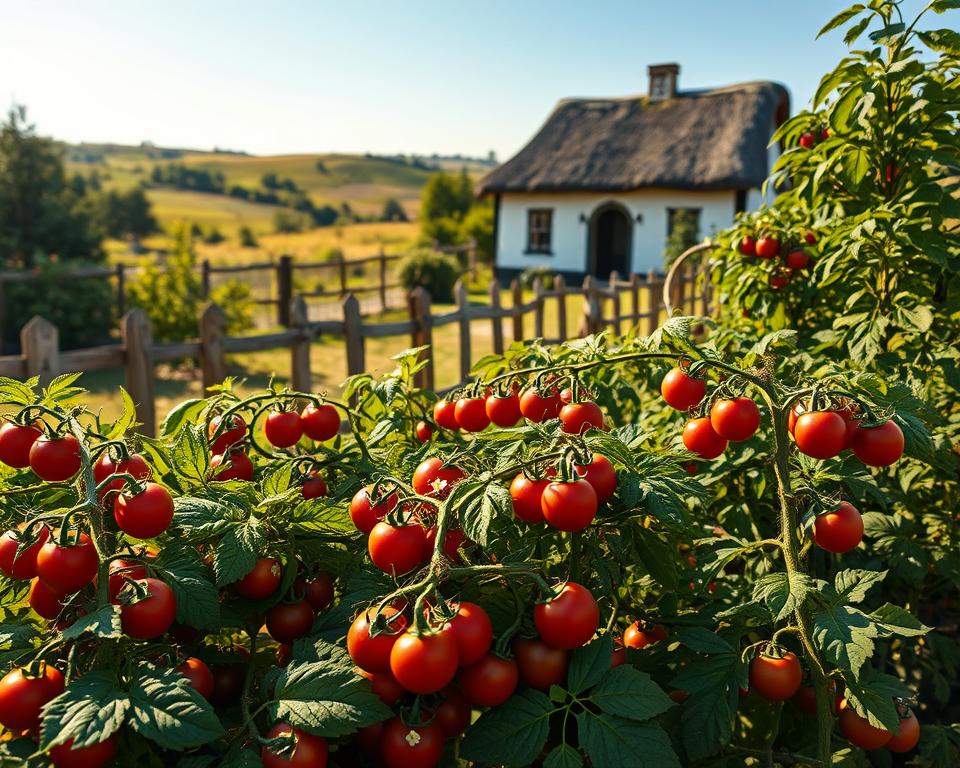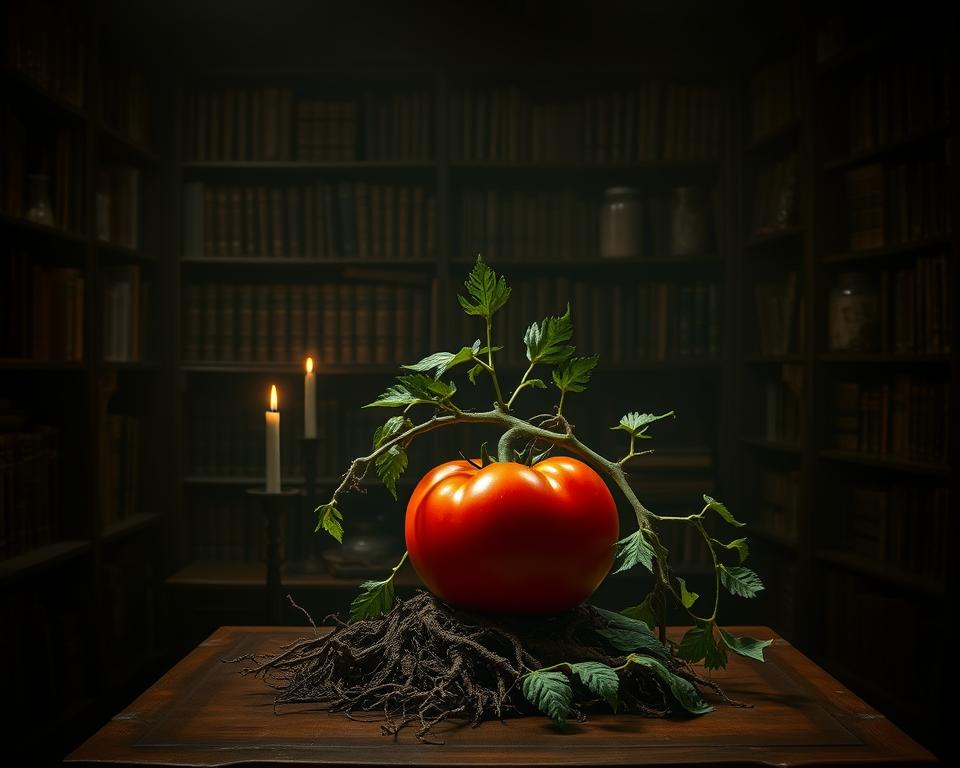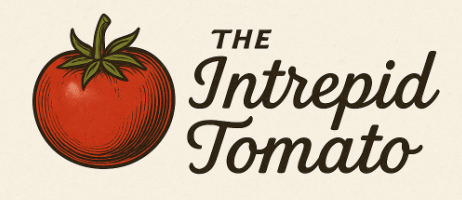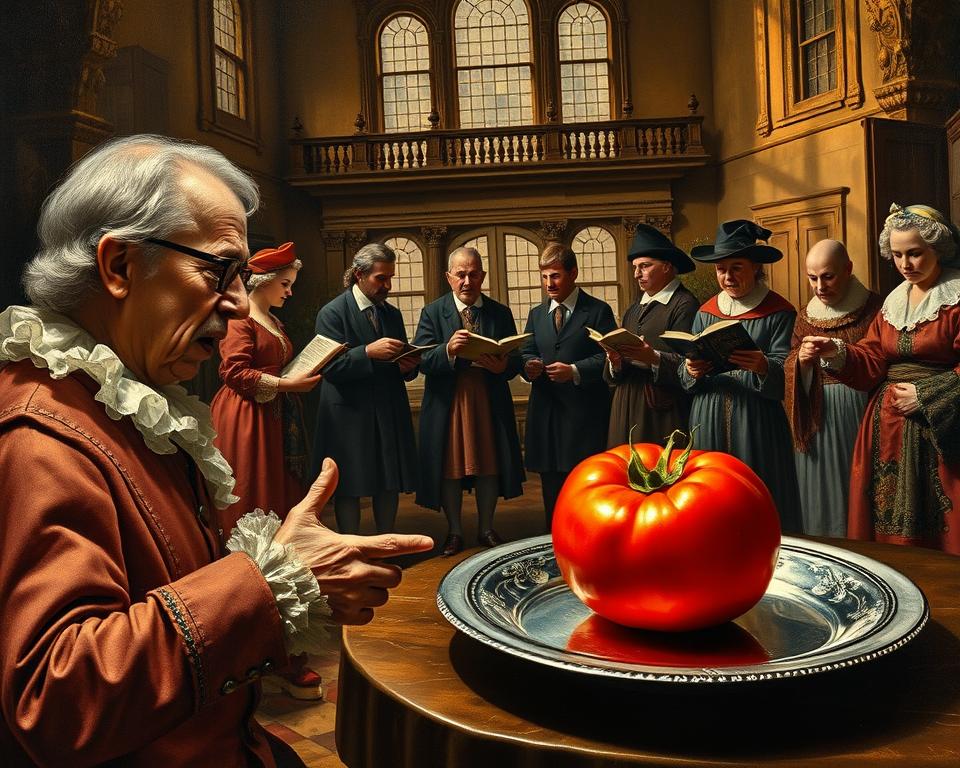Colonial Confusion: How the Tomato Was Mistaken for a Lethal Plant
We often overlook the history of foods we eat every day. The tomato, a key ingredient in many dishes, was once feared. People thought it was dangerous.
In the old days, Europeans believed tomatoes were poisonous. This belief lasted for over a century. Even in the 1800s, some in America thought they were toxic.
As we look into how tomatoes came to America, we see the historical inaccuracies around them. This shows how myths can spread and change over time.
Learning about the history of food and cultural exchange helps us understand these myths. It shows how wrong beliefs can be cleared up.
The Journey of Tomatoes to Colonial America
As European colonization grew, the tomato, a New World fruit, made its way back to the Americas. It faced skepticism along the way. The path of tomatoes to colonial America was complex, shaped by culture and geography. Let’s look at how tomatoes became a key part of American food.
Origins in Mesoamerica and Indigenous Uses
The tomato came from the Andes Mountains of South America. The Aztecs in Mesoamerica domesticated it. Native peoples used tomatoes in their food, mixing them with local ingredients for flavor.
Their use of tomatoes helped start its cultivation and introduction to European food.

Spanish Explorers and European Introduction
Hernán Cortés brought tomatoes to Europe after conquering the Aztec capital in 1519. At first, Europeans were wary of tomatoes because of their bright color and their family ties to poisonous plants. But, tomatoes eventually became accepted in European cooking, mainly in Spain and Italy.
Tomatoes’ introduction to Europe was a key step in their journey to colonial America. European colonizers brought tomatoes and their cooking ways to the Americas. This greatly influenced the food habits of colonial America.
Arrival and Initial Reception in North American Colonies
As Europeans settled in North America, tomatoes were brought along. But, many colonists were cautious, believing tomatoes were poisonous. This fear was fueled by the idea that tomatoes were harmful, a belief that lasted for a while.
The slow acceptance of tomatoes was also due to social and economic factors. As trade and cultural exchange grew, tomatoes became more available. This helped overcome the initial doubts about them.
Looking at tomatoes’ journey to colonial America, we see how culture, economy, and food shaped their history. Tomatoes’ story is a great example of how food preferences and myths change over time, influenced by many historical and social factors.
Colonial Tomato Misconceptions: The Deadly Nightshade Connection
In colonial America, tomatoes were seen with suspicion. This was because they belonged to the nightshade family. This family includes plants that are toxic.

The Nightshade Family Classification and Its Reputation
The nightshade family, or Solanaceae, has many plants, some very toxic. Species like deadly nightshade (Atropa belladonna) and black nightshade (Solanum nigrum) are well-known for their danger. This made people wary of other plants in this family, including tomatoes.
Some parts of the tomato plant, like the leaves, do contain toxic compounds. But, the fruit is safe to eat. This fact wasn’t well-known back then.
Scientific Understanding and Botanical Confusion in Colonial Times
In the colonial era, understanding plants was limited. Botanical classification was just starting. The confusion between edible and toxic plants led to fear of tomatoes.
Tomatoes were also new to many Europeans. This made them even more suspicious. It took time for people to start using tomatoes in cooking.
Documented Cases of “Tomato Fear” in Early American Settlements
In early American settlements, tomatoes were often feared. In some places, they were grown more for looks than for eating. This showed how widespread the belief was that tomatoes were unsafe.
It wasn’t until more was learned about tomatoes that they became common in American cooking. This change came with the influence of European cooking styles.
The Science Behind the Confusion
Tomatoes in colonial America were misunderstood due to science and culture. We must look at the reasons behind this confusion.
Tomato Plant Toxicity vs. Fruit Safety: Separating Fact from Fiction
The tomato plant’s toxicity was a big confusion point. The leaves and stems have harmful compounds called glycoalkaloids. But, the tomato fruit is safe to eat. This fact was hard for colonial Americans to grasp.
The tomato is in the nightshade family, which includes deadly plants. This made people fear tomatoes. Yet, the fruit’s safety was a truth waiting to be accepted.
Acidic Interactions with Pewter Plates and Lead Poisoning
Tomatoes were also seen as dangerous because of their acid. This acid could release lead from pewter plates, causing poisoning. This was a big problem for the wealthy, who used pewter.
People blamed tomatoes for the lead poisoning, not the pewter. This made tomatoes seem unhealthy.
Class Distinctions in Food Consumption and Knowledge
Class also played a part in how people viewed tomatoes. The wealthy were more cautious about tomatoes in their food. The poor, with less access to European foods, were more open to them.
This difference in food culture and knowledge slowed the spread of tomato facts. As more people learned about tomatoes, the negative views started to fade.
Brave Pioneers Who Challenged Tomato Myths
Exploring tomatoes in colonial America reveals key figures who debunked myths. These pioneers, with their bravery and creativity, transformed tomatoes from a feared plant to a beloved food.
Robert Gibbon Johnson’s Public Demonstration
Col. Robert Gibbon Johnson is a key figure in tomato history. In 1820, he ate a tomato on the Salem County courthouse steps in New Jersey. This act was a bold move to show tomatoes were safe.
Johnson’s tomato-eating helped ease local fears. It marked a significant shift in how Americans viewed tomatoes.
Thomas Jefferson’s Role in Tomato Cultivation
Thomas Jefferson, a founding father, was also a tomato advocate. He grew tomatoes at Monticello, trying different varieties and recipes. His love for tomatoes showed his openness to new foods.
Jefferson’s support for tomatoes influenced many. His endorsement helped the fruit gain acceptance among the American elite.
European Culinary Influences
European immigrants also shaped tomato acceptance in America. They brought their cooking traditions, including tomato-based dishes. Italian, Spanish, and French cuisines were key in making tomatoes popular.
Tomatoes became a staple in many dishes. This exposure helped Americans understand and enjoy their flavor, dispelling old myths.
From Feared Poison to American Culinary Treasure
The history of tomatoes in colonial America is quite interesting. It’s a story of how misconceptions turned into acceptance. Pioneers played a big role in changing how people saw tomatoes. They challenged old myths about these fruits.
European cooking traditions also helped. They showed Americans that tomatoes were good to eat. This helped clear up some old beliefs about tomatoes from the colonial era.
Now, tomatoes are a key part of American food. Their popularity keeps growing. The story of tomatoes in America shows how culture and beliefs can change.
When we eat tomatoes in salads, sauces, or sandwiches, we celebrate their journey. We remember the historical and cultural reasons they became so popular.

